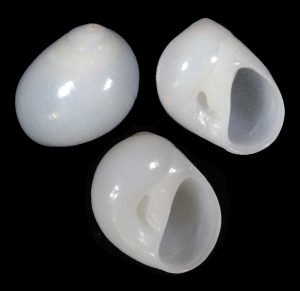Family Naticidae
Shell size to 8 mm; shell globose. Spire low. Body whorl encompassing most of shell. Surface glossy with faint growth lines. Periostracum brown, very thin. Umbilicus chink-like or completely covered by callus. Color light tan with irregular reddish-brown markings. Do not confuse with juvenile Polinices duplicatus.
Read MoreShell size to 50 mm; shell flat, ovoid body whorl comprising most of shell. Very large, flared aperture. Sculpture of many impressed axial and transversal lines. Color milk white. Common sand-burrowing species. The mantle of the living snail almost completely covers the shell, as shown in the second image.
Read MoreShell size to 30 mm; shell similar to Sinum perspectivum, but with apex more elevated, aperture less flared. Color light-brown or buff white with irregular darker brown markings.
Read MoreShell size to 10 mm, shell ovoid-globose, glossy. Suture well defined. Sculpture of 2-6 widely separated, incised lines below suture (arrows). Umbilicus deep, without callus. Color white. Do not confuse with Polinices lacteus, which has a narrower shell with thicker walls and lacks the incised lines below suture.
Read MoreShell size to 30 mm; shell ovoid, with thin periostracum. Sutures poorly defined. Shell surface smooth, aperture with strong, sometimes convex parietal callus, that extends into, and in some cases obliterating, the deep umbilicus. Not common on the barrier islands of Southwest Florida, the shell illustrated was collected by Susan J. Hewitt on West Gulf Drive Beach, Sanibel, in December 2013.
Read MoreShell size to 80 mm; shell globose with four to five solid whorls. Spire low, with apex not elevated, to high. Umbilicus almost always covered by purple-brown callus. Operculum horny. Color grayish to dirty-white. The additional shell illustrated is a juvenile collected by Susan J. Hewitt on Gulf Side City Park in December 2011.
Read MoreShell size to 70 mm; shell globose with four to five solid whorls. Spire moderately elevated. Umbilicus almost always associated with a brown callus. Umbilicus delimited by a noticeable edge in adult specimens. Operculum horny. Color grayish to dirty-white. This species is distinguishable from the similar Neverita duplicata by its higher spire and umbilicus delineated by moderately sharp edge. The photo of the living animal was taken on February 22, 2012, on Kice Island, Collier Co., FL, by Linda Shockley.
Read MoreShell size to 38 mm; shell globose, thin-walled. Umbilicus white, deep, filled in part by white, plug-like callus. Operculum calcareous, white, with about 7-12 spiral ridges. External surface of operculum with about ten strong grooves. Background color white, with alternating reddish brown and yellowish bands with transverse, wavy, dark brown bands. Aberrant shells lacking the bands and other color elements are not very uncommon (see supplementary image of live animal with shell lacking major color elements). The pictures of the live specimen were taken by Amy Tripp in Marco Island, Collier County, in December 2012. The photo of the live animal with "even-colored" shell was taken by David Graff (Florida DEP) on Keewaydin Island, also in Collier County, December 2015. And the shell on the extreme right of the illustration, with operculum and collected dead by Amy Tripp on Kice Island, received the "Marilyn Northrop Award for Shell of the Show, Self-Collected" at the 2016 Sanibel Shell Show.
Read More






